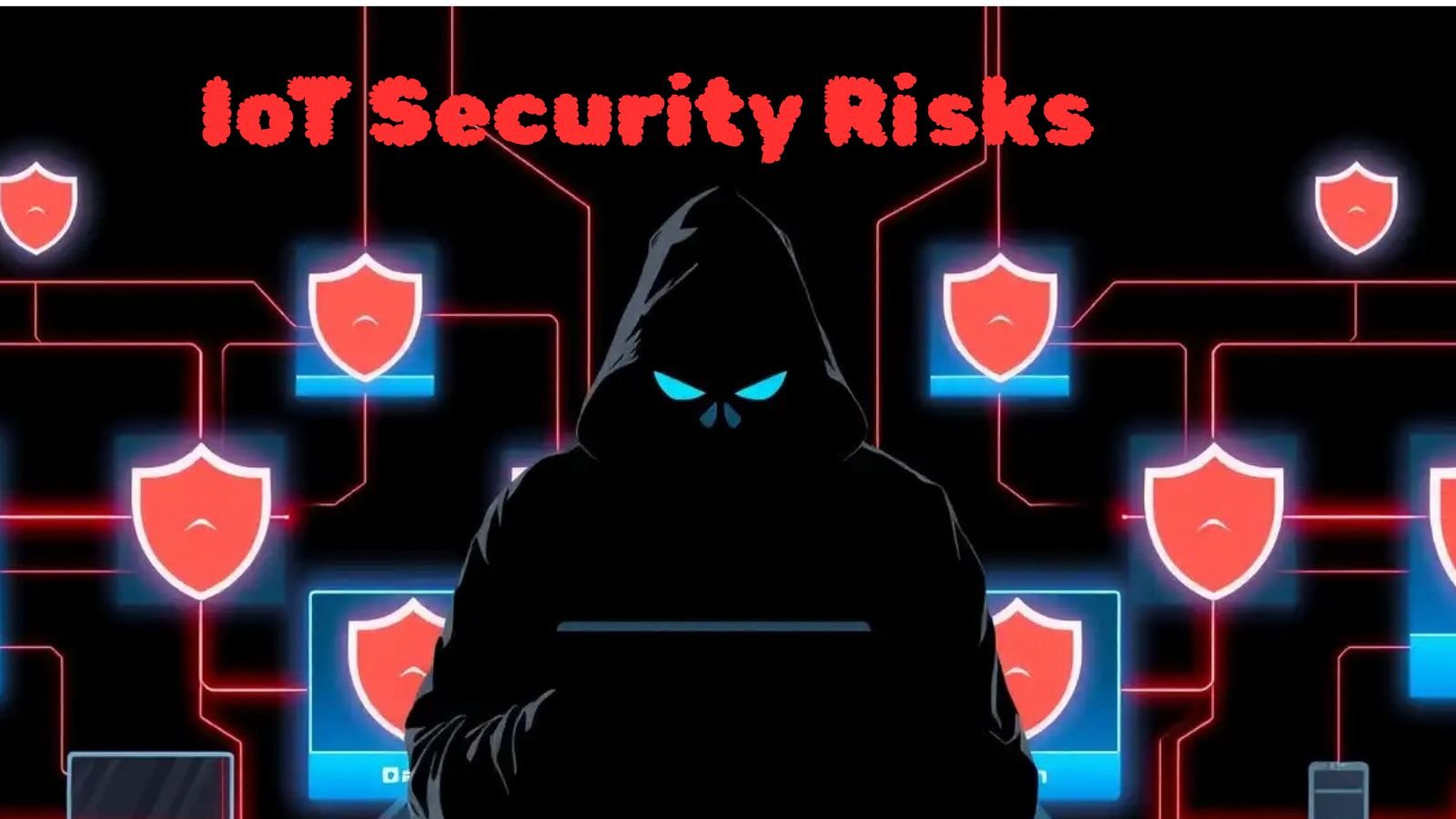The Risks of IoT Devices and How to Mitigate Them
Protect your smart home from hackers, data breaches, and unauthorized access with this comprehensive security guide
SEO Information
Focus Keyphrase
IoT security risks
Featured Image Prompt
Hacker silhouette attacking a network of smart home devices with shield icons protecting them. Dark background with glowing red threat lines and blue security barriers
The Hidden Dangers in Your Smart Home
Internet of Things (IoT) devices have transformed modern living, offering unprecedented convenience through connected smart homes. However, this technological revolution comes with significant security risks that many homeowners overlook. From smart speakers and thermostats to security cameras and door locks, each IoT device represents a potential entry point for cybercriminals. Shockingly, IoT cyberattacks exceeded 112 million incidents in 2022 alone, highlighting the critical need for robust security measures.
Unlike traditional computing devices, many IoT products prioritize functionality over security, shipping with weak default passwords, unencrypted data transmission, and minimal authentication requirements. These vulnerabilities can lead to devastating consequences, including data breaches, identity theft, unauthorized surveillance, and even physical security compromises. In this comprehensive guide, we’ll examine the most critical IoT security risks and provide actionable strategies to protect your smart home ecosystem.
Critical IoT Security Risks
Understanding these vulnerabilities is the first step toward securing your smart home ecosystem:
Weak Authentication & Default Passwords
Many IoT devices ship with generic default credentials like “admin/admin” that users never change. Attackers exploit these weak passwords using automated tools to gain remote access. Once compromised, devices can become entry points to your entire network.
Real-world impact: The 2016 Mirai botnet attack compromised over 145,000 devices using default credentials, launching massive DDoS attacks that disrupted major websites, including Netflix and Twitter.
Unencrypted Data Transmission
Many IoT devices transmit sensitive data without encryption, making communications vulnerable to interception. This includes video feeds, location data, and personal information that can be captured through “man-in-the-middle” attacks.
Critical vulnerability: Unencrypted data flows between devices and cloud servers expose credentials and personal information that hackers can harvest.
Insecure Firmware & Lack of Updates
Many IoT devices run outdated firmware with known vulnerabilities. Manufacturers often neglect to provide regular security patches, and 60% of devices lack secure over-the-air (OTA) update capabilities.
Long-term risk: Unpatched vulnerabilities in medical devices like pacemakers could allow life-threatening remote manipulation.
Physical Tampering & Theft
Devices in accessible locations can be physically compromised. Attackers may insert malicious USB devices, steal components, or extract data directly from poorly secured hardware.
Physical threats: Thieves target IoT components like SIM cards for identity theft, while tampering can create backdoor access to networks.
Insecure APIs & Cloud Interfaces
Application Programming Interfaces (APIs) that connect devices to cloud services often lack proper authentication. Vulnerable APIs enable attackers to manipulate devices or exfiltrate data.
API dangers: Compromised interfaces allowed hackers to breach Target’s network through an HVAC vendor’s IoT sensors, stealing millions of credit card details.
Third-Party Supply Chain Risks
Many IoT manufacturers incorporate third-party components with hidden vulnerabilities. Compromised firmware or libraries can undermine even well-secured devices.
Supply chain attacks: Vulnerabilities in one vendor’s components can affect thousands of IoT products across multiple brands.
The 2016 Mirai Botnet Attack: A Cautionary Tale
In 2016, a college student unleashed the Mirai botnet by compromising over 145,000 IoT devices—primarily security cameras and DVRs—using default credentials. This army of infected devices launched massive distributed denial-of-service (DDoS) attacks that crippled internet infrastructure across Europe and North America.
The attack peaked at nearly 1 terabyte per second of malicious traffic, overwhelming servers and taking down major websites including Twitter, Netflix, and CNN. The Mirai source code was later released online, enabling countless copycat attacks. This incident demonstrated how vulnerable IoT devices can become weapons in large-scale cyber warfare when basic security measures are neglected.
7 Mitigation Strategies for IoT Security
Protect your smart home with these proactive security measures:
1. Implement Strong Authentication Protocols
- Change default credentials immediately during setup using complex, unique passwords
- Enable multi-factor authentication (MFA) wherever possible, especially for admin accounts
- Implement biometric authentication on supported devices for enhanced security
- Use password managers to generate and store strong credentials.
2. Encrypt Data at Rest and In Transit
- Enable TLS/SSL encryption for all device communications
- Use VPNs for remote access to your smart home network
- Choose devices with end-to-end encryption for sensitive data like video feeds
- Verify encryption protocols during device selection :cite[5]:cite[9]
3. Establish Robust Network Security
- Segment IoT devices onto separate networks using VLANs or a dedicated IoT WiFi network
- Implement firewalls to restrict device communication to essential services only
- Disable unused ports (like MQTT port 1883 and CoAP port 5683) on your router.
- Use enterprise-grade routers with robust security features instead of ISP-provided equipment
4. Maintain Firmware and Security Updates
- Enable automatic updates where available
- Regularly check manufacturer websites for security patches
- Replace devices that no longer receive updates
- Consider end-of-life policies when purchasing IoT products.
5. Secure Physical Access Points
- Install devices in secure locations to prevent tampering
- Use tamper-evident casings for outdoor and accessible devices
- Disable unused physical ports like USB on IoT devices
- Implement environmental sensors to detect physical tampering.
6. Conduct Regular Security Audits
- Inventory all IoT devices and their security status
- Monitor network traffic for unusual activity
- Perform vulnerability scans quarterly
- Use security tools that provide Layer 1 visibility to detect rogue devices.
7. Adopt a Zero-Trust Architecture
- Verify every device and user before granting network access
- Implement strict access controls based on least-privilege principles
- Use device certificates for authentication
- Assume all devices are potentially compromised.
Building a Secure Smart Home Ecosystem
Creating a protected IoT environment begins with strategic planning:
Choosing Secure Devices
Prioritize devices with built-in security features like:
- Automatic encryption (TLS/SSL)
- Regular firmware updates
- Hardware security modules
- Matter and Thread protocol support for standardized security.
Implementing Centralized Management
Use a secure smart home hub like Samsung SmartThings to manage devices through a single, secured interface. Centralized hubs reduce attack surfaces by eliminating the need for multiple apps and cloud connections.
Future-Proofing with AI Security
Emerging AI-powered security systems can:
- Detect anomalous behavior in real-time
- Automatically quarantine compromised devices
- Predict vulnerabilities before exploitation
- Provide autonomous threat response.
Your Action Plan for IoT Security
Implement these steps today to significantly enhance your smart home security:
- Conduct a device audit: Catalog all IoT devices and check security settings
- Change credentials: Replace default passwords with strong, unique alternatives
- Segment your network: Create a dedicated IoT network separate from main devices
- Enable encryption: Activate WPA3 and device encryption where available
- Update firmware: Install the latest security patches for all devices
- Configure monitoring: Set up network alerts for suspicious activity
- Review permissions: Limit data collection to essential functions only
For comprehensive guidance on setting up a secure smart home foundation, explore our Ultimate Smart Home Automation Guide.
Download Our IoT Security Checklist
Conclusion: Security as an Ongoing Practice
IoT security is not a one-time setup but a continuous process of vigilance and adaptation. As the number of connected devices per household approaches, the attack surface expands exponentially, making comprehensive security practices essential.
By implementing the strategies outlined here—strong authentication, network segmentation, regular updates, and continuous monitoring—you can significantly reduce your vulnerability to IoT threats. Remember that security is a layered approach: no single solution provides complete protection, but combined measures create a robust defense ecosystem.
Stay informed about emerging threats and solutions by subscribing to our Security Bulletin, and regularly revisit your security configurations to ensure your smart home remains a safe haven rather than a vulnerability.

